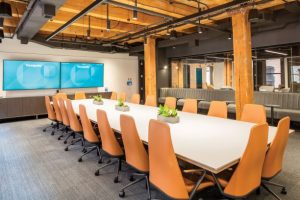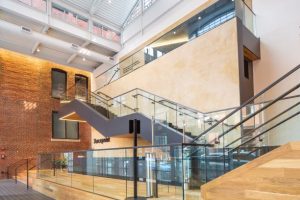THE PEOPLE PARADIGM: Forcepoint’s Cyber Experience Center
When most people think of cybersecurity, they think of dark, shadowy forces and firewalls—not people. Cybersecurity firm Forcepoint is disrupting that preconception, both in their behavior-based approach to protecting data and the building they created to showcase it.
“Forcepoint is redefining cybersecurity to be human-centric,” says Chris Staal, vice president of global real estate and facilities at Forcepoint. “Our company vision is to understand the world’s cyber behaviors so we can ‘stop the bad and free the good.’ People are at the center of that.”
Accordingly, the company wanted to create a space where they could connect with their clients face-to-face and demonstrate the power of their solutions. The first step in that process was choosing a location. Based in Austin, Texas, Forcepoint was looking to add an East Coast location that could better suit the busy schedules of their C-suite clientele in the Eastern US and in Europe. Boston fit the bill perfectly. “Boston’s Innovation District was a natural fit for us,” says Staal. “We’re literally driving innovation, and a brick-and-beam structure that’s been there since 1907 seemed like a perfect accent to speak to our authenticity.”

THAT “AHA” MOMENT
With Gensler as their design partner, Forcepoint focused on what they wanted this client briefing center to be, visiting a number of briefing centers in New York and Northern California for inspiration. Those visits then drove the focus of their visioning session which, says Staal, made their purpose abundantly clear: it’s all about the experience.
“The centers that gave us an ‘aha’ experience were the ones we liked best,” he says. “We always knew we wanted an ‘aha’ moment of our own, and as we got to the top of the staircase in the atrium of our building, we knew that spot was it.”
Forcepoint brought in Structure Tone to help them build out that vision, which included a two-story atrium entrance that leads users to the second-floor “Showcase” space. There, visitors are surrounded by floor-to-ceiling glass panels that demonstrate the full impact of the company’s systems. The rest of the 53,000sf facility includes a large briefing center, office space for Forcepoint’s behavioral analytics team, and several smaller break-out rooms, meeting spaces, and even private offices, all tailored to the needs of the executives who, in many cases, traveled from afar to be there.

NEW MEETS OLD
Bringing this people-first, forward-looking vision into a historic building took some creative thinking. First, the area for the Showcase is actually a two-story infill building between two existing five-story buildings, which includes independent rooftop units. As part of the new lease with Forcepoint, the building owner replaced those units with new, more efficient equipment. As the team started building out the Showcase space, it became clear that vibration from the AC units above could affect the vision, calling for suspending projectors from the ceiling. Forcepoint brought the project team together to brainstorm and test options that could make this suspended Showcase vision viable.
“The first thought was to add extra structural steel to bolster the support,” says Mike Ryan, Structure Tone senior vice president. “But we advised that would be complicated and expensive, with no guarantee it would completely solve the issue.”
So the team went back to the drawing board, with Staal particularly working closely with his AV consultant, DCL, to come up with options. Ultimately, they determined that instead of isolating the vibration across space, they would isolate it at each projector, placing neoprene spacers around each connection point to provide a cushion between the beams and the projector, clamps, and metal supports. At the same time, the landlord upgraded the springs and curbs of the units and rerouted air ducts to avoid the projectors. “We knew this was the experience we wanted, so we didn’t give up,” says Staal. “Structure Tone did not shrink away once, through many rounds of testing and asking them to remove certain things and put others back. Their level of attention, detail, and understanding just came through time and time again.” Noise was also proving an issue given the building’s high ceilings. With the team’s “we can do this” mentality at work, Structure Tone suggest-ed adding poured flooring insulation to dull the sound travel. And those are just a few examples of creative decision-making on the fly. “I have to give it to the whole team,” says Ryan. “We just didn’t give up and leaned on each other to figure out a way to make this work.”
BETTER TOGETHER
Ultimately the team did just that, perfectly blending the aesthetic and authenticity of the historic building with the ultra-modern technology and purpose Forcepoint housed within it. “The elements I like most are also a bit of a juxtaposition,” explains Jeanne Nutt, principal and managing director of Gensler Boston. “On the one hand, there’s the grand entrance that brings you up the stair-case to the Showcase. It really creates the ‘wow’ moment as intended.”
At the same time, there are so many details from the original building that we were able to retain and integrate into the design.”
In the months that followed the ribbon-cutting—attended by such dignitaries as Massachusetts Governor Charlie Baker—clients were coming and had the exact experience Forcepoint had hoped for. Then COVID-19 stopped the world in its tracks. Staal and his team discovered an added benefit of their building that they never would have anticipated.
“With the entire building to ourselves and a dedicated customer entrance, we can tell customers unequivocally that no one has come into that space other than us,” says Staal. “Our space is for them. When customers are ready to come back, we are ready.”
Despite the unexpected pandemic pause, the entire team—and especially Staal—count the project as a huge success and testament to the power of a great team. “The project would never have happened if Gensler, Structure Tone, and all of our partners didn’t come together to solve the problems in front of us,” he says. “How many times in your career do you really get to make a contribution that truly enables your company and drives its revenue? I’m proud and thankful I got to experience that.”
